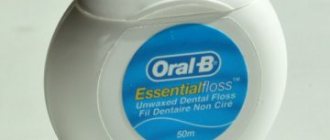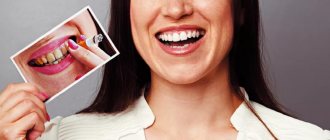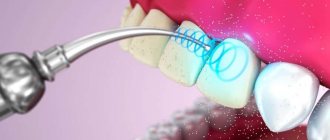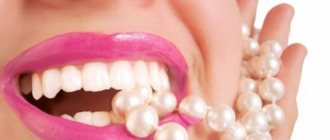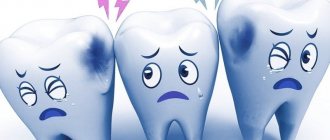When should you use mouthwash?
With halitosis. If bad breath occurs frequently, a mouthwash will help remove it. It reduces the number of bacteria, slows down their reproduction, and cleans even those areas that cannot be reached with a toothbrush (subgingival, interdental areas, surface of the tongue, gums, cheeks). When rinsing, residues and food particles are washed away, which can cause an unpleasant odor.
If caries appears frequently. It is formed when plaque accumulates on the enamel, when the acidity in the mouth becomes too high (including due to the active growth of bacteria). Antibacterial solutions help reduce acidity, and additional cleansing reduces plaque formation. The mouthwash may contain fluorides or other mineral components that strengthen the enamel, restore its structure, and protect against caries.
With the rapid appearance of tartar. It is formed when soft plaque hardens. It can only be removed with professional cleaning. To prevent tartar from appearing again, effective hygiene is important. Using rinses, you can slow down the formation of deposits: they wash the enamel surface, remove food particles, slow down the growth of bacteria, and help keep teeth clean throughout the day.
If the enamel is highly sensitive. In this case, you need to use solutions with a mineralizing effect. They must contain fluorides. When rinsed, they penetrate the enamel structure, restore it, strengthen it and reduce sensitivity. It’s good if the solution is also antibacterial: it will help reduce acidity in the mouth, eliminating pain.
For bleeding or inflammation of the gums. The use of solutions with anti-inflammatory and antibacterial effects is part of the prevention and treatment of gum disease. They help relieve inflammation, accelerate the healing of the mucous membrane, and slow down the formation of tartar under the gingival margin.
How does professional cleaning happen in the doctor's chair?
Hygienists have several professional teeth cleaning tools at their disposal. One of these tools using Air Flow
. This is a device that promotes hygiene with the help of a fine sand-like abrasive placed in this device, that is, it cleans the teeth and the surface of the teeth from soft and hard stone. I do my own oral hygiene this way - I like it. Air Flow is more gentle and gentle. And if you work with four hands with an assistant, it is very convenient for the patient.
But ideally, to ensure proper dental hygiene, you need to use the entire range of tools that exist.
In addition to Air Flow, there is also ultrasound - an ultrasonic scaler.
This is an attachment that is installed on the scaler itself.
Ultrasonic movements help remove hard plaque.
How to remove tartar in hard-to-reach places
In addition to ultrasound, there is mechanical cleaning using a Gracie curette
. This is a special instrument designed to do mechanical cleaning and hygiene began with these curettes.
Curettes are a handle with a working part on each side. The working part is a sharp edge. The angles of inclination on one side of the curette and on the other are different. The curette is convenient to work on both the upper and lower jaws. That is, it is convenient to get to - easy access.
An American housewife invented curettes.
Part of the plaque is removed mechanically and then polished using a soft brush and paste. Great practical feminine approach, isn't it? PS
Visiting the dentist twice a year was invented back in the Soviet Union under Soviet healthcare, and it was actually considered one of the best, by the way.
What types of mouth rinses can there be?
For self-hygiene, solutions with antibacterial, antiseptic, mineralizing, anti-inflammatory, and antifungal effects can be used. It is better to use a rinse selected by your dentist or hygienist, taking into account the condition of your teeth and gums.
Mineralizing. The basis of the solution is sodium fluoride or olafur. This is a mineral component that can penetrate the enamel structure and strengthen it. After rinsing, a protective film is formed on the surface of the teeth. It lasts for several hours, “saturating” the enamel with minerals. The use of such rinses reduces the risk of caries and reduces the sensitivity of enamel.
Antiseptic. The main component may be chlorhexidine, triclosan, or benzydamine in low concentrations. The solution destroys bacteria, protects against gum disease, slows down the formation of tartar, and improves the condition of gingivitis and some other diseases. After tooth extraction, rinsing with antiseptic solutions may be prescribed to reduce the risk of inflammation or dry socket formation. Rinse aids with an antiseptic effect are used as prescribed by the attending physician. They are usually used as part of complex therapy in the treatment of periodontitis, gingivitis and other inflammatory diseases. You cannot use them for too long: this is dangerous due to dysbacteriosis of the oral cavity, dry mucous membranes, and the appearance of halitosis.
Health-improving. They are made from extracts or decoctions of herbs, using essential oils. The effect is mild, supportive or preventive (not pronounced enough if treatment of existing diseases is needed). Such rinses can contain extracts of chamomile, myrrh, sage, eucalyptus, sea buckthorn, hawthorn, essential oil of geranium and other plants. Their effect is anti-inflammatory, restorative, restoring local immunity. Such products are used as a means of daily hygiene. Even with long-term use they do not cause side effects.
Alcohol based. They are classified as antiseptic, used as prescribed by a doctor, the ethanol content can be up to 27%. Effective for halitosis and inflammatory diseases of the oral cavity. They cannot be used by minors, people for whom alcohol is contraindicated, or drivers (after rinsing, the breath may contain alcohol vapor, and this is recorded during testing with a breathalyzer).
Some rinses are used as prescribed by a doctor for specific diseases or conditions. They may include:
- diphenhydramine - for a local allergic reaction;
- xylocaine or lidocaine - anesthetic effect (temporarily removes sensitivity);
- nystatin, betamethasone, stomatidine - for aphthous stomatitis and other acute inflammations;
- benzydamine is a pain reliever.
Medicines for the treatment of viral diseases of the oral mucosa
I. Pain relievers
First of all, to treat a child suffering from acute and recurrent herpetic stomatitis, in order to relieve or weaken painful symptoms in the oral cavity, an affordable and very effective anesthetic is used - anesthetic ointment to lubricate the oral mucosa before eating and treating the oral cavity.
II. Specific antiviral agents for local therapy
- Bonaftone ointment
- 0.5%. Antiviral activity is manifested in its influence on the processes of HSV reproduction. Lubricate the oral mucosa 3-4 times a day after meals. - Tebrofen ointment
- 0.25 and 0.5%. It has an antiviral effect due to the ability to suppress the growth of viruses. The ointment is effective in the treatment of acute and recurrent herpetic stomatitis, and also acts against the influenza virus and adenovirus infection. It is recommended to lubricate the mucous membrane 3-4 times a day.
- Florenal ointment
— 0.5%. Provides high neutralizing activity against HSV. Does not have an irritating effect on the mucous membrane; lubricate the mucous membrane 2-4 times a day.
- Adimal ointment —
0.5%. Has high neutralizing activity against influenza virus and HSV.
- DNase —
A 1% solution that has the ability to prevent the intracellular proliferation of DNA-containing viruses. Available in bottles of 25-50 mg. The contents must be dissolved before use in 5 ml of isotonic sodium chloride solution.
- Oxolinic ointment
- 0.25%. The most widely used ointment with antiviral effect. The virucidal effect of the ointment is especially evident in relation to the influenza virus, adenovirus, and, to a lesser extent, to HSV.
- Riodoxol ointment
- 0.25 and 0.5%. It has antiviral and antifungal effects, and has virus-neutralizing activity against influenza and herpes viruses. In case of possible side effects (burning, hyperemia of the mucous membrane), the drug is discontinued. Lubricate the mucous membrane with a thin layer 1-3 times a day.
- Alpizorin ointment
— 2.5%; alpisarin liniment - 5%. It has high activity against DNA-containing viruses. To treat affected areas of the skin, 5% alpisarin ointment is used; for damage to the oral mucosa, 2% ointment is applied 4-6 times a day. The drug is characterized by good absorption, anti-inflammatory effect, and a high chemotherapeutic index. It has immunostimulating properties regarding cellular immunity. Compared to bonaftone, alpizarin is less toxic.
- Gossypol
— 3% liniment. Has an antiviral effect, weakly active against gram-positive microorganisms. Gossypol liniment is available in 20 g jars. The drug is well tolerated.
- Megosin ointment
- 5%. It is a drug synthesized from gossypol, has virucidal activity against HSV, an interferon inducer, the drug has proven itself in the treatment of recurrent herpetic stomatitis.
Interferon preparations. Interferon in ampoules of 500 U/ml actively suppresses the reproduction of most known viruses, which prevents the development of the infectious process. It is characterized by harmlessness, absence of side effects and allergic reactions. It is used in the treatment and prevention of acute and recurrent herpetic stomatitis, viral warts in children.
- An aqueous solution of leukocyte human interferon for instillation into the nasal and oral cavity - 3-5 drops per day after meals.
- Interferon ointment based on vinylin is prepared according to the recipe: interferon - 2.0 x 10 IU/g; anesthesin - 0.1; vinylin - 10.0. Stir thoroughly before use. Indications for the use of interferon ointment are all forms of viral infection in children.
- Zovirax (acyclovir)
acts selectively on cells infected with HSV and on viral DNA polymerase. Has low toxicity to cells not infected with the virus. It has immunostimulating properties and has an anti-relapse effect. It is used for herpetic stomatitis, ophthalmic herpes in the form of a 3% ointment on a soft paraffin base, and for herpes of the lips in the form of a 5% cream on a white aqueous creamy base. The drug is applied 5 times a day for 5 days. Treatment is recommended to begin in the prodromal period.
Agents that stimulate interferon formation in the body. One of the simplest methods is ultraviolet radiation.
- Poludan
has the ability to stimulate the production of endogenous interferon and has an antiviral effect. Used as eye drops. The contents of the ampoule (0.0002 g) must be dissolved in 2 ml of distilled water and instilled 6-8 times a day.
III. Medicines with local symptomatic action
Antiseptic treatment of the oral mucosa is indicated for advanced and severe forms of the disease and precedes the use of antiviral drugs. In dentistry, antimicrobial agents are widely used for antiseptic treatment. These include: 1% solution of sanviritrin; 0.5% etonium solution; 0.5% solution of sodium mefenaminate, etc. New aerosol preparations have antiseptic, anti-inflammatory, analgesic effects. However, their use in children is not always desirable due to the freon content, the cooling effect, possible allergic reactions, and also because of the fear that they often cause in children.
- Ambassador
The composition includes propolis, which has anti-inflammatory, disinfectant, analgesic and antiviral properties. Should be used if you are not allergic to bee products.
- Kameton
- an aerosol combination preparation containing chlorobutanol hydrate, camphor, menthol, eucalyptus, vaseline oils and freon.
- Devovinisol
consists of chloramphenicol, vinylin, linetol, citral and ethyl alcohol. It has the properties of a broad spectrum antibiotic - chloramphenicol and the anti-inflammatory properties of its components. Contraindicated in case of intolerance to chloramphenicol and microflora resistance to it.
- Libyan
- an anti-inflammatory, disinfectant and keratoplasty drug having a combined composition (linetol, anesthesin, etc.).
IV. Proteolytic enzymes
They have pronounced antiseptic and proteolytic properties. In addition to the main necrolytic effect, enzymes enhance and restore the phagocytic activity of neutrophilic leukocytes and fibroblasts, which contributes to the rapid course of regeneration processes. To effectively cleanse the affected mucous membrane of necrotic masses, trypsin, chymotrypsin, chymopsin, solutions of DNase, ronidase, terrilitin, hygrolitin are used.
- Trypsin
- a proteolytic enzyme that has a pronounced anti-inflammatory effect. Available in ampoules containing 0.01 and 0.005 g of trypsin. The contents of the ampoule are dissolved in 5 ml of distilled water before use.
- Chymotrypsin
- proteolytic enzyme of the pancreas. Its action is similar to trypsin and has the same indications for use. Available in ampoules of 0.01 and 0.005 g. The contents of the ampoule are dissolved in 5 ml of isotonic sodium chloride solution.
V. Keratoplasty agents
During the period of epithelization, keratoplastic substances are prescribed to accelerate the healing processes of the lesion elements. Symptomatic agents that promote epithelialization include a 1% oil solution of citral, rosehip oil, aloe ointment, carotoline, an oil solution of vitamin A, solcoseryl (jelly and ointment), as well as alazol and inosol aerosols. All drugs are used in the form of applications 3-4 times a day.
- Solcoseryl
- a combined preparation consisting of solcoseryl, polidocanol and ointment base. The action of the ointment is based on the ability to activate fibrinolysin, accelerate the growth of fibroblasts, increase energy exchange in tissues and reduce swelling. Available in the form of ointment and jelly to lubricate the mucous membrane.
- Rosehip oil, sea buckthorn oil, carotoline and vitamin A oil solution are used for applications and lubricating the mucous membrane.
VI. General therapy drugs General specific and nonspecific antiviral and immune therapy drugs.
- Bonafton
- tablets of 0.1 and 0.25 g; taken orally, without chewing, an hour after meals, 1 (0.25 g) tablet. 5 times a day; course of treatment is 5 days. The drug is most effective when used in combination with local antiviral agents. Possible side effects: headache, dyspepsia.
- Alpizarin
is available in the form of tablets of 0.1 g. The drug is well absorbed, exhibits antiviral activity due to its inhibitory effect on HSV reproduction, has a high immunotherapeutic index, and stimulates cellular immunity. The use of the drug from the first days of the disease gives a positive therapeutic effect.
Alpizarin tablets are taken orally, regardless of meals. Adults are prescribed 0.1 g, the course of treatment is 10-15 days; children - 1/2 table. 3 times a day for 7 days. Recommended for use in combination with local treatment.
- Zovirax (acyclovir)
has pronounced antiherpetic activity. Effective in patients with herpes with immune deficiency of various origins. Zovirax for internal administration is available in vials containing 250 mg of sterile acyclovir. The solution must be prepared immediately before use by adding 10 ml of isotonic sodium chloride solution. The dose for children is calculated per body surface area in accordance with the instructions for use of the drug.
- Interferon
has an inhibitory effect on a wide range of viruses. The mechanism of antiviral action is its penetration into the cell followed by the synthesis of an antiviral protein, which prevents or suppresses the reproduction of viruses.
Used as an anti-relapse agent. It has no contraindications and is available in ampoules of 500 units/ml. Directions for use: intramuscularly, 1 ml every 3-4 days, course - 4-5 injections.
- Reaferon
- a domestic drug used for the treatment of various viral diseases: hepatitis B, influenza and its complications, ophthalmic herpes and genital herpes. Treatment with reaferon in children affected by the virus is carried out according to the following scheme: intramuscular injection of 500,000 units once a day. Course - 5 injections with an interval of 1-2 days. After the 1st course of therapy in case of repeated recurrence and no tendency to improve the condition within 5-6 months. a repeat course is prescribed according to the same scheme.
After treatment with Reaferon, most children experience a positive therapeutic effect. Children tolerate the drug well, no side effects or allergic reactions are observed. In case of continuously recurrent form of herpetic stomatitis in children for 1-2 months. there is a gradual decrease in the severity of symptoms of a general and local nature, until complete disappearance. Reaferon helps to interrupt the permanent course of the disease, increase remission, and in some cases lead to clinical recovery.
- Decaris (levamisole)
selectively stimulates the regulation of T-lymphocyte function, plays the role of an immunomodulator, enhancing the cellular immune response. When treating children with recurrent herpetic stomatitis, it helps prevent relapses. Children are prescribed 50 mg after meals once on the recommendation of a pediatrician. There are no side effects with a single use. Take in tablet form, 1/2 tablet. per day for 3 days with a break of 5 days between cycles. The total course of treatment is 2-3 cycles.
Flexible prostheses.
Removable dentures made of nylon or polyurethane are easy to remove from the mouth and clean by hand. The first thing to do is to rinse them with water (it is best to use boiled water), as this is the fastest, easiest and most effective way to remove food debris from dentures of this type; however, it is not sufficient for its complete comprehensive cleaning. The mechanical action of a soft toothbrush can achieve better cleaning of the denture, but it is necessary to use a special paste (flexible dentures are cleaned with a brush simultaneously with rinsing with water). Therefore, there are special solutions for flexible dentures. For some time (from 15–20 minutes to several hours), the prosthesis is immersed in a special antiseptic liquid. Solutions are sold ready-made or prepared by simply dissolving an antiseptic concentrate in water.
How does oral hygiene change with age?
Age is not kind to teeth. Just like the musculoskeletal system, teeth and gums wear and change with age. Diseases, one-sided nutrition and medications, unfortunately, leave their mark: they lead to dry mouth and reduce salivation. And the latter is very important due to its antibacterial properties, which inhibit the growth of bacteria that cause caries and periodontal disease. In addition, saliva regulates the acid-base balance in the mouth and helps reduce the effects of acids responsible for disrupting the mineralization of tooth enamel and the occurrence of caries.

